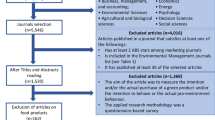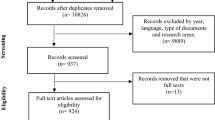Abstract
Stated preference values for water quality ratings based on the US Environmental Protection Agency National Water Quality Inventory ratings provide an operational basis for benefit assessment. Iterative choice survey results for a very large, nationally representative, Web-based panel imply an average valuation of $32 for each percent increase in lakes and rivers in the region for which water quality is rated “Good.” Valuations are skewed, with the mean value more than double the median. Sources of heterogeneity in benefit values include differences in responses to average water quality information and the base level of water quality. Conjoint estimates are somewhat lower than the iterative choice values. The annual economic value of the decline in inland US water quality from 1994 to 2000 is over $20 billion.
Similar content being viewed by others
References
Bishop RC, Heberlein TA (1990) The contingent valuation method. In: Johnson RL, Johnson GV (eds) Economic valuation of natural resources: issues, theory, and applications, social behavior and natural resources series. Westview Press, Boulder
Bishop RC, Welsh MP (1992) Existence values in benefit-cost analysis and damage assessment. Land Econ 68(4): 405–417
Boyle KJ, Bishop RC, Welsh MP (1985) Starting point bias in contingent valuation bidding games. Land Econ 61: 188–194
Carson RT, Mitchell RC (1993) The value of clean water: the public’s willingness to pay for boatable, fishable, and swimmable quality water. Water Resour Res 29(7): 2445–2454
DeShazo JR (2002) Designing transactions without framing effects in iterative question formats. J Environ Econ Manage 43: 360–385
Eom Y-S, Larson D (2006) Improving environmental valuation estimates through consistent use of revealed and stated preference information. J Environ Econ Manage 52(1): 501–516
Freeman AM III (2003) The measurement of environmental and resource values: theory and methods, 2nd edn. Resources for the Future, Washington, DC
Frykblom P, Shogren JF (2000) An experimental testing of anchoring effects in discrete choice questions. Environ Resour Econ 16: 329–341
Heberlein TA, Wilson MA, Bishop RC, Schaeffer NC (2005) Rethinking the scope test as a criterion for validity in contingent valuation. J Environ Econ Manage 50: 1–22
Herriges JA, Shogren JF (1996) Starting point bias in dichotomous choice valuation with follow-up questioning. J Environ Econ Manage 30: 112–131
Huber J, Viscusi WK, Bell J (2006) Economics of environmental improvement. Report submitted to US EPA under CR823604 and R827423
Huber J, Viscusi WK, Bell J (2007) Task and context effects in valuations from iterative choices. Fuqua School of Business, Duke University working paper. Forthcoming in Organizational Behavior and Human Decision Processes
Kahneman D, Knetsch JL (1992) Valuing public goods: the purchase of moral satisfaction. J Environ Econ Manage 22: 57–70
Louviere JJ (1988) Conjoint analysis modeling of stated preferences: a review of theory, methods, recent developments and external validity. J Trans Econ Policy 22: 93–119
Louviere JJ, Hensher DA, Swait JD (2000) Stated choice methods: analysis and applications. Cambridge University Press, Cambridge
Magat WA, Viscusi WK, Huber J (1988) Paired comparison and contingent valuation approaches to morbidity risk valuation. J Environ Econ Manage 15: 395–411
Magat WA, Huber J, Viscusi WK, Bell J (2000) An iterative choice approach to valuing clean lakes, rivers and streams. J Risk Uncertain 21(1): 7–43
Rowe RD, d’Arge RC, Brookshire DS (1980) An experiment on the economic value of visibility. J Environ Econ Manage 7(1): 1–19
Smith VK (1987) Non-use values in benefit-cost analysis. South Econ J 54: 19–26
Smith VK, Desvousges WH (1986) Measuring water quality benefits. Kluwer Academic Publishers, Boston
Smith VK, Osborne LL (1996) Do contingent valuation estimates pass a ‘scope’ test? A meta-analysis. J Environ Econ Manage 31(3): 287–301
Train KE (2003) Discrete choice methods with simulation. Cambridge University Press, Cambridge
United States Environmental Protection Agency (1994–2002) National water quality inventory, report to congress, EPA 841-R-94-001 (1992 Report), EPA 841-R-95-005 (1994 Report), EPA 841-R-97-008 (1996 Report), EPA 841-R-00-001 (1998 Report), EPA 841-R-02-001 (2000 Report)
US Department of Commerce (2003) Statistical abstract of the United States. Bernan Press, Washington, DC
Viscusi WK, Magat WA, Huber J (1991) Pricing environmental health risks: survey assessments of risk–risk and risk–dollar tradeoffs for chronic bronchitis. J Environ Econ Manage 21(1): 32–51
Author information
Authors and Affiliations
Corresponding author
Rights and permissions
About this article
Cite this article
Viscusi, W.K., Huber, J. & Bell, J. The Economic Value of Water Quality. Environ Resource Econ 41, 169–187 (2008). https://doi.org/10.1007/s10640-007-9186-4
Received:
Accepted:
Published:
Issue Date:
DOI: https://doi.org/10.1007/s10640-007-9186-4




